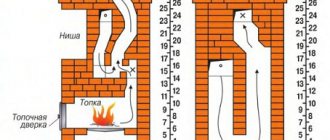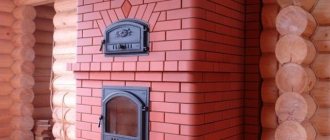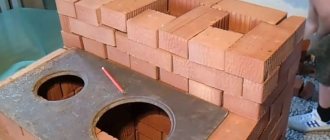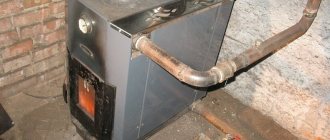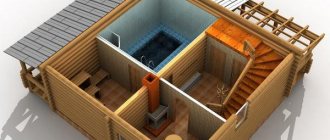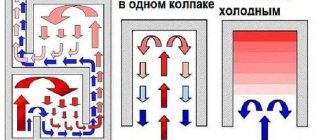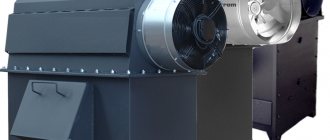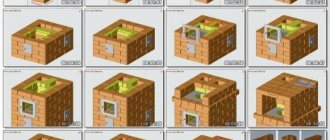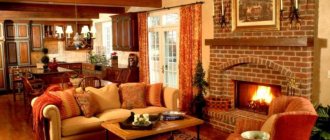Stove maker.. +375 (29) 127-50-30
If you call a stove maker and start asking him what size the stove should be in your house, you can believe that each stove maker will give you his own estimate. It’s good if you come across a competent and decent specialist and correctly calculate the optimal size of the stove, based on the characteristics of your home or premises. But this doesn't always happen. You must understand that the work of a stove maker depends on the amount of brick that will be used to lay the stove, and therefore it is important for many stove makers to include a larger size than necessary in the stove design. In this case, you may receive a stove with too high thermal characteristics, which will lead to unnecessary costs on your part for its construction and operation.
It must be said that quite often there are cases when the Customer, due to his financial condition, asks to build a small or small stove. In this case, a situation may arise that this stove will not be able to warm up the room in the house and will simply be ineffective. You will simply heat it for wear and tear and significantly increase the consumption of firewood.
The stove in the house must have optimal dimensions, calculated on the basis of the characteristics of the premises of the house, which include such as the area of the heated room, insulation of the house, the type of stove and its shape, and some others.
Before looking for a stove maker, calculate what size your stove should be. Knowing this data, you can have a reasoned conversation with any Stove Man and convincingly appeal to him.
Payment service tarexi.by © 2020
About filling out the Service parameters.
Indicate the area of the heated room.
In this section you need to indicate what area of the room you want to heat. It should be noted that the heated area refers not only to the area of a single room, but also to all adjacent rooms if you plan to install a stove for their joint heating.
Our Service performs calculations based not on the volume of premises, but on their area, since it is often difficult to calculate the volume of a room, but many people know the area of their rooms or can easily calculate it. The calculation itself includes a direct relationship between the volume and area of the room with the condition of a ceiling height of 2.5 m. If you have a higher ceiling, you can slightly increase the area of the room for a more accurate calculation
Decide on the type of stove.
In this Service, calculations are performed only for heating and heating-cooking rectangular stoves, since these are the most common types of stove structures.
It is necessary to select one of the types of furnace structures to perform the calculation. If you have not yet decided on your choice, then it’s okay, choose any type of stove. At least you will still know the size of your future furnace and the amount of bricks for its construction.
The type of heating stoves can include any rectangular stoves (for example, sauna stoves), except for stoves with cooking surfaces and portal fireboxes (for example, Russian stoves).
Select a home insulation category.
Insulation of the house is important for determining the mass of the stove and its dimensions. You understand, the more insulated the house is, the more heat from the stove will remain in it. Heat loss is a very serious indicator of thermal characteristics and therefore, to simplify the calculation, we divided the insulation of a house into 3 categories: average, good and weak.
You will decide for yourself which insulation category your home or cottage fits into. For a more accurate selection of this category, we will compile a table a little later, but for now we ask you, without hesitation, to determine and indicate how well your house or cottage is insulated. For example, in most cases, dachas should be classified as medium or even weak insulation categories. Residential buildings with a wall thickness of more than 63 cm and strong insulation of ceilings have good insulation.
Indicate one of the sides of your future stove.
For the Customer, this calculation item is the most important and interesting. The fact is that the most important and problematic issue for the Customer is the size of his oven. Knowing this size, you can completely make any plans for the repair and reconstruction of premises, layout of furniture, design of rooms, pouring a stove foundation, etc. To calculate it, you need to know approximately the length of at least one of the sides of the stove. For example, you had an old stove and you knew its size and want the same size on one side, or you have an opening in the wall of adjacent rooms into which you want to place the stove array.
The size of the furnace side is selected in increments of 12.5 cm. If you do not know which side you should have, then enter any one, and using the selection method, select the optimal size of the furnace structure for you. The calculation is carried out automatically, taking into account errors in the entered data. If the size is entered incorrectly, the calculation will be performed to the nearest correct side size parameter.
Calculate the oven size.
After filling out all the details and clicking on the “Perform calculation” button, the Service will automatically calculate the size of the furnace and show how many bricks are needed for laying this furnace structure.
Note that the data is relatively accurate and deviations in accuracy can be no more than 2-3%. Knowing them, you can talk to the stove maker and set him the task that you need to lay out a stove of a specific size. And since the quantity of bricks is also known, you can plan the costs of laying the stove and purchasing materials.
For example, you need to determine what type of stove I should have to heat a room in a 20 m2 country house. The dacha is well insulated and I want to install a purely heating stove (as it is also popularly called a “grupka”).
Masonry of a Russian stove
Before work, it is important to study the designs of Russian stoves. There are different options, so the masonry scheme may differ
The drawings cannot be changed - the specified order must be strictly followed.
Complete tightness is important for the safety of the structure. This is ensured by the following points:
- Use quality stone. There shouldn't be any cracks.
- The seams between the rows are 0.5-0.8 cm thick.
- Do not coat the inner walls with clay - soot will be deposited on them, and therefore thermal conductivity will decrease.
- Different departments differ in the thickness of the masonry from ¼ of the thickness of the brick to its full length.
- If the brick is ceramic, then it needs to be soaked to prevent moisture from being absorbed from the mortar.
Mortar for laying the stove
The thinness and elasticity of the composition and the absence of cracks after drying are important. You can use a ready-made mixture from the store or make it yourself. For this you need purified clay. It needs to be soaked in water, and after a day kneaded with sand - first, several variations of the solution are made for testing, changing the proportions. From each they form cakes, 1 cm thick. After 2-3 days they are examined - where there are fewer cracks, the composition is better.
To ensure uniformity of the clay, after soaking it is wiped through a mesh with 0.5 cm cells. When preparing the solution for the firebox, it is better to replace ordinary sand with fireclay powder. Mix it with clay 1:3(4).
Furnace device
For a good flow of air to the firewood, the furnace firebox is mounted with a grate and a blower. The grate is made of cast iron and serves to support burning wood or coals.
It is made with longitudinal through holes or slots. For larger fireboxes, the grate is made from special single parts - grates.
Blower is an opening in the furnace under the firebox, designed to improve draft and remove burnt ash. If the heating device is made not of brick, but of metal, then it is necessary to provide protection for the firebox from overheating. It is also recommended to build a chamber of heat-resistant fireclay bricks in stone heating devices.
Criterias of choice
- The design of the furnace must be the same size as the area allocated for its installation. The amount of heat transfer depends on compliance with this rule.
- Choose the right oven shape. For heating the room, a shape is suitable where the side walls are long and the front and back walls are narrow.
- The stove must be located in the house in such a way that it does not disturb anyone and at the same time is in its place to perform certain functions.
- A small house does not need a massive stove - its impressive dimensions will not warm the house faster. It is better to have a smaller oven that quickly reaches the desired temperature than a large and wasteful one.
Diagram of the simplest brick stove for a summer house and home
A heating stone stove in general looks like this:
- Below the floor level there is a foundation on which the insulation is laid.
- Trenches are installed on the floor - legs that provide heating to the lower part.
- Directly above them there is a blower, as well as a choke. It is needed for uniform heating throughout the height.
- It is separated from the main room by a blower door.
- Directly above it is the firebox. A grate is placed at its bottom, which is also the roof of the ash pit.
- Directly above the firebox door is the arch of the firebox, behind which is the hailo or mouth.
- Above that, the cleaning, the pass and the convectors begin.
- There are two valves located above the cleaning.
- Almost at the very top there is an outlet for the air vent into the room, a smoke channel and a ceiling.
- The chimney is separated from the ceiling by an internal trim.
- At the very top is the mouth of the chimney.
Features of the order of brick stoves
Stoves often serve as interior decoration, so they are lined with clinker, tiles, and tiles. The diagonals in the first row are carefully measured, and a plumb line is hung in the center of the chimney, which is removed on the last rows of the pipe. Also, the diagonals are controlled every 4 rows, and on each row a cord is pulled during installation, which is checked by the rule. Instead of cement-sand mortar, it is recommended to use clay, regardless of the type of furnace being built. Ready-made dry solutions significantly save time spent on clay preparation. To prevent the composition from drying out quickly, the brick must be moistened with water before laying.
Operating costs will be lower if there are no rectangular ledges inside the structure. For this purpose, when creating an overlap (ledge), the stone is tried on without mortar, the overlap line is outlined, and the excess material is cut off with a grinder. Internal seams during laying are regularly checked, and excess mortar is removed from time to time. The pipe is cleaned after completion of the work.
Brick kilns are made of several materials:
- external cladding;
- masonry bricks (main structure);
- fireclay – fireproof material is used to lay out areas exposed to strong heat (furnace, under);
- bricks with high-density edges are located inside the oven.
Clay bricks should not be mixed with fireclay, and ovens, hobs, rods and grates, and water tanks should not be embedded in the masonry - this is due to different expansion coefficients when heated. If metal elements are rigidly embedded in the masonry, the structure will soon collapse.
Type of material for the project
Scheme of laying furnace rows.
The outer layer of the project is usually made of ceramic bricks. This material is easy to process and has sufficient thermal conductivity.
When purchasing, carefully inspect its surface. High-quality stones of this type have no differences in color over the entire surface, there are no cracks or chips, and the geometry meets the standards.
The furnace firebox requires special refractory bricks that can withstand high temperatures and are highly durable. The latter property is both an advantage and at the same time a disadvantage, since it complicates its mechanical processing.
Refractory bricks are made in various forms. Moreover, it has no voids. This type of artificial stone can withstand temperatures of +1400… +1600 ºС. It differs from the usual type in its composition and characteristic metallic ringing when struck.
It is made from special refractory clay in industrial ovens at very high temperatures. This material has clear edges, which makes it possible to make precise geometric structures from it. But refractory bricks have a fairly high cost. Therefore, it is recommended to divide the building into external and internal decoration.
This allows you to significantly reduce project costs without compromising its safety and thermal conductivity.
